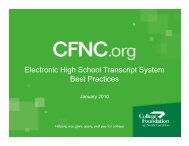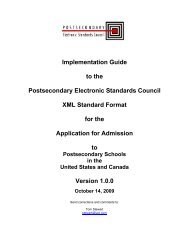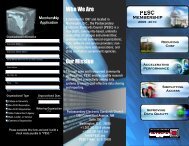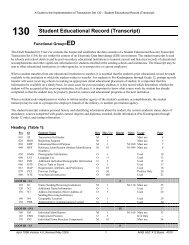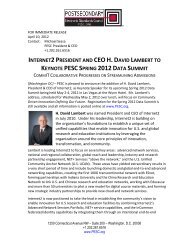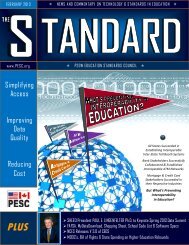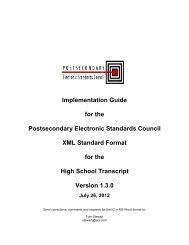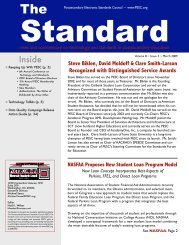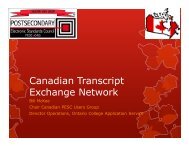Public Key Infrastructure and Higher Education - PESC
Public Key Infrastructure and Higher Education - PESC
Public Key Infrastructure and Higher Education - PESC
- No tags were found...
You also want an ePaper? Increase the reach of your titles
YUMPU automatically turns print PDFs into web optimized ePapers that Google loves.
PKI Work Group<strong>Public</strong> <strong>Key</strong> <strong>Infrastructure</strong><strong>and</strong> <strong>Higher</strong> <strong>Education</strong>:An IntroductionA <strong>Public</strong>ation of thePostsecondary Electronic St<strong>and</strong>ards CouncilWashington, DCMay, 2000
Table of ContentsCredits…………….……………………………………………………………………..ivExecutive Summary……………………………………………….…………………….v1 Introduction……………………………………………………..………………..11.1 The Purpose of <strong>Public</strong> <strong>Key</strong> <strong>Infrastructure</strong> (PKI)………………………...……11.2 Underst<strong>and</strong>ing <strong>Public</strong> <strong>Key</strong> <strong>Infrastructure</strong> <strong>and</strong> Technology………………….2Cryptography OverviewDigital Signatures <strong>and</strong> <strong>Public</strong> <strong>Key</strong> EncryptionWhere Does <strong>Infrastructure</strong> Come In?PKI Process Flow1.3 Policy – The PKI Document Set………………………………...……………..41.4 Models of PKIs…………………………………………………………………..5Closed Model (Enterprise Model)Network Model (Community of Interest Model)Open Model1.5 A PKI Model for <strong>Higher</strong> <strong>Education</strong>………………………………………….…61.6 Reference URLs…………………………………………………..…………….72 The Use of PKI in <strong>Education</strong> <strong>and</strong> Other Industries………………………….82.1 The University of Texas System (UT) – Closed Model……………….…….82.2 University of California (UC) – Closed Model……………………..…………92.3 Automotive Network eXchange (ANX) – Network Model………………....102.4 The Digital Library Federal – Network Model…………………………..…..112.5 GSA ACES – Open Model……………………………………………………112.6 ABA Trust ID® Program – Open Model…………………………………….123 Issues in Deploying <strong>and</strong> Using <strong>Public</strong> <strong>Key</strong> Technology in <strong>Higher</strong><strong>Education</strong>……………………………………………………………………….13iii
3.1 Acceptance by Consumers………………………………………...…………13Access to the TechnologyEase of useTechnical Support3.2 Trust………………………………………………………………………..……13ConfidentialityPrivacy3.3 Interoperability………………….………………………………………………14St<strong>and</strong>ardsTechnical interoperabilityPolicy InteroperabilityOther Interoperability Initiatives: Federal Bridge CA <strong>and</strong> NACHA3.4 <strong>Key</strong>Storage……………………………………………………………..…………..153.5 Certification Authority Services………………………………………………16Technology Knowledge <strong>and</strong> ImplementationsPolicies <strong>and</strong> ProceduresData Processing <strong>and</strong> Facility RequirementsRisk <strong>and</strong> LiabilityApplications SupportedCustomer Support4 Work Group Recommendations…………………………………..………….19iv
PKI Work Group MembersDavid Leonard, USA Group, ChairJohn Barkley, NISTAndrew Boots, US Department of <strong>Education</strong>Michael Capps, Ed FundDavid Garver, ScienceWiseDan Geller, NCSCasey Lide, EDUCAUSEKelly Newcomb, TGSLCJan Nielsen, Campus PipelineWally Reeves, University of Texas at AustinPat Salava, <strong>Education</strong>al Testing ServiceMichael Sessa, NASLAPaul Soohoo, <strong>Education</strong>al Testing ServiceShelby Stanfield, University of Texas at AustinCraig Yamamoto, Ed FundThis document was produced by members of the PKI Work Group in collaborationwith technical consultants from Digital Signature TrustKeren Cummins, Vice President, Government ServicesDebbie Blanchard, Sales EngineerLouis Jurgens, Sales ManagerTim Pinegar, Senior EngineerThe Chair wishes to give special recognition to Work Group members Andy, Dan,Casey, Wally, <strong>and</strong> Paul <strong>and</strong> staff members Betsy <strong>and</strong> Andrew for theircontributions.~The Postsecondary Electronic St<strong>and</strong>ards CouncilOne Dupont Circle, NW, Suite 520Washington, DC 20036(202) 293-7383http://www.St<strong>and</strong>ardsCouncil.org© May 2000v
<strong>Public</strong> <strong>Key</strong> <strong>Infrastructure</strong> <strong>and</strong> <strong>Higher</strong> <strong>Education</strong>: An IntroductionExecutive SummaryThe Postsecondary Electronic St<strong>and</strong>ards Council (<strong>PESC</strong>) created a <strong>Public</strong> <strong>Key</strong> <strong>Infrastructure</strong>(PKI) Work Group to determine how PKI can serve the needs of the higher education community.In this paper we examine the purpose of PKI <strong>and</strong> how it works in general, show how it has beenimplemented to date in higher education <strong>and</strong> elsewhere, discuss various models of PKI <strong>and</strong> theissues involved in an open PKI system, <strong>and</strong> present our recommendations for <strong>PESC</strong> support ofPKI in higher education.IntroductionPKI can provide assurances that data sent electronically over open networks arrive unaltered,unseen by unauthorized persons, from an authenticated sender who cannot deny sending thedata. Without some or all of these assurances, there is not the required secure environment formany electronic transactions to take place.As students, schools, lenders, service providers, <strong>and</strong> state <strong>and</strong> Federal agencies move frompaper to electronic data exchanges of student data over the Internet, security concerns becomeimportant not only to the senders <strong>and</strong> receivers of this data but also to the public at large.Federal laws, regulations, <strong>and</strong> trading partner requirements for providing security with traditionalpaper processes <strong>and</strong> limited electronic exchanges must be adhered to in electronic dataexchanges in an open environment. Digital signatures <strong>and</strong> encryption achieved through the useof a PKI can satisfy the required security attributes.DiscussionA PKI, based on asymmetric or public key cryptography, incorporates the hardware, software,policies <strong>and</strong> procedures that allow previously unknown parties to exchange data in a secureenvironment. Two PKI models—closed (or enterprise) <strong>and</strong> network (or community of interest)—are found in use in various industries. A third model—open—is still in the conceptual stages.When fully realized, it will make available a “portable Internet credential” with broad utility evenoutside the originating community. The <strong>PESC</strong> community, with its singular focus on the entirehigher education enterprise, is broad enough to feel the need for the open model PKI.Individual universities <strong>and</strong> university systems are establishing their own closed PKIs to allowstudents, faculty, <strong>and</strong> administrators to use information technologies to improve the way theyaccomplish their business. Review of other network <strong>and</strong> open models such as the US GeneralServices Administration ACES project <strong>and</strong> the American Bankers Association TrustID initiative,provide examples for higher education to consider in the move from institutional closed PKIs to aneventual network <strong>and</strong> open PKI.Challenges for implementation of a broader-based PKI in higher education revolve aroundacceptance of the technology by users, trust in the process, interoperability, the issuessurrounding provision of certification authority services, <strong>and</strong> costs.RecommendationsThe <strong>PESC</strong> PKI Work Group recommends that <strong>PESC</strong> encourage electronic commerce in highereducation by fully supporting <strong>and</strong> promoting the use of PKI. Its role would focus on research <strong>and</strong>sharing of technical, legal <strong>and</strong> policy information with members of the higher educationcommunity <strong>and</strong> on the cooperation with existing <strong>and</strong> new initiatives to employ PKI technology inhigher education. The Work Group recommends a st<strong>and</strong>ing committee be formed <strong>and</strong> a PKIexpert be engaged to provide appropriate information on the topic on a continuing basis.vii
1 IntroductionThe revolution in the delivery of services through electronic means that is taking place in the commercial <strong>and</strong>government worlds has a special resonance for the higher education community -- a community that existsentirely for the communication of knowledge <strong>and</strong> information. The Postsecondary Electronic St<strong>and</strong>ards Council(<strong>PESC</strong>) comprises a diverse group of organizations that have entered into partnership within the highereducation community for the purpose of improving service <strong>and</strong> controlling costs through the promotion ofst<strong>and</strong>ards for data sharing.The higher education community <strong>and</strong> those that support it--campus administrative offices, testing services,financial aid lenders, servicers <strong>and</strong> guarantors, <strong>and</strong> state <strong>and</strong> federal agencies--are finding more ways toprovide better service <strong>and</strong> cut costs by taking advantage of electronic delivery of computerized data. As paperprocesses are replaced by electronic data sharing, current <strong>and</strong> potential trading partners must agree on dataformats, code sets, encryption schema, <strong>and</strong> other st<strong>and</strong>ards to facilitate the flow of information. To that end, the<strong>PESC</strong> <strong>Public</strong> <strong>Key</strong> <strong>Infrastructure</strong> (PKI) Work Group was charged to investigate industry, state, <strong>and</strong> federal effortsto establish <strong>and</strong> regulate public key infrastructure (PKI) components of public key cryptography, digitalsignatures, digital certificates <strong>and</strong> certification authorities for secure Internet data exchanges.This paper is intended to examine, from the perspective of the <strong>PESC</strong>, how PKI, or public key infrastructure, canprovide a cornerstone for furthering that revolution in the higher education community. The paper will examinethe purpose of PKI <strong>and</strong> how PKI works in general; how PKI is working in current implementations in highereducation <strong>and</strong> elsewhere; what special concerns higher education may need to address in the future; majorissues in the implementation of PKI in an open system, <strong>and</strong> the Work Group’s recommendations for furtheraction by <strong>PESC</strong>.1.1 The Purpose of <strong>Public</strong> <strong>Key</strong> <strong>Infrastructure</strong> (PKI)In the conventional world of business <strong>and</strong> professional communications, basic assumptions can be made whena transaction is conducted using original signed documents, delivered in sealed packages directly to theparticipating parties. Generally, organizations that use the public network to transmit business communicationsmust underst<strong>and</strong> with whom they are dealing; that no one has altered the content of the communication after itwas signed; that no one unauthorized has seen the information; <strong>and</strong> that the signer of the document cannotdeny having sent the document. These are the fundamental assurances that make transactions betweenremote parties possible.Simply stated, the most fundamental purpose of a PKI – a public key infrastructure – is to provide these sametypes of assurances about the content <strong>and</strong> parties to transactions that take place over an open network,sometimes among parties not otherwise known to each other. By enabling the use of digital signatures <strong>and</strong>encryption, PKI can provide the same four basic security services for today’s data transmissions:• Authentication — Ensure that transmissions <strong>and</strong> messages, <strong>and</strong> their originators, are authentic, <strong>and</strong>that a recipient is eligible to receive specific categories of information.• Data Integrity — Ensure that data is unchanged from its source <strong>and</strong> has not been accidentally ormaliciously altered.• Non-repudiation — Ensure strong <strong>and</strong> substantial evidence is available to the sender of data that thedata has been delivered (with the cooperation of the recipient), <strong>and</strong>, to the recipient, of the sender’sidentity, sufficient to prevent either from successfully denying having sent or received the data. Thisincludes the ability of a third party to verify the integrity <strong>and</strong> origin of the data.• Confidentiality — Ensure that information can be read only by authorized entities.In addition, PKI can also offer additional security services not offered by a paper process, including:1
• Authorization –- Ensure that the user, either sender or recipient, is authorized for access to data,systems, or applications• Availability – Ensure that legitimate users are not unduly denied access to information <strong>and</strong> resourcesThe term “public key infrastructure” or “PKI” refers to a complex suite of hardware, software <strong>and</strong> particularcryptographic components, combined with adherence to policies <strong>and</strong> procedures that enable businessapplications to operate in a secure environment. The particular cryptographic components used are those ofpublic key, or asymmetric, cryptography. To discuss how PKI can serve higher education it is fruitful to reviewhow those technologies, particularly digital signatures, actually work.1.2 Underst<strong>and</strong>ing <strong>Public</strong> <strong>Key</strong> <strong>Infrastructure</strong> <strong>and</strong> TechnologyTo underst<strong>and</strong> a PKI, it is important to underst<strong>and</strong> how public key technology is used to encrypt <strong>and</strong> sign anelectronic message. A digital signature is not a digitized image of a h<strong>and</strong>written signature, nor is it a PIN or apassword. Rather, a digital signature is an attachment to an electronic message that includes a mathematicaldigest of the message, created using public key cryptography. As a result, a digital signature is specific both tothe signer of an electronic document or message as well as to the electronic document or message itself. Thus,a digital signature can be used to affirmatively identify both.Cryptography OverviewThere are two fundamental types of cryptography, symmetric cryptography <strong>and</strong> asymmetric or public keycryptography. Each of these cryptographic systems has distinct characteristics <strong>and</strong> is used in differentways to provide general security services.Symmetric cryptography is the most familiar. It is based on a shared secret, or key, <strong>and</strong> works well withinisolated environments. A simple example of symmetric cryptography is seen when children create a "secretcode" by converting all the letters of the alphabet to their numeric equivalents, 1-26, <strong>and</strong> then adding, say,the number five. The child receiving the secret message has only to subtract five from each number inorder to be able to reconstitute the correct numbers for the original message. The shared secret is thenumber five. In real commercial uses of symmetric cryptography, the algorithm used to encrypt may beenormously more complex. The challenge is communicating a secret key between the sender <strong>and</strong> receiverwithout anyone else finding out, because anyone who might intercept the key would be able to read,modify, or forge messages that were encrypted or authenticated using that key.The inherent problem with symmetric cryptography is one of scalability. In order for the communications tobe confidential, the exchange of a key, or shared secret, must be done securely between every pair ofparticipants. Obviously, this type of secure distribution becomes increasingly difficult as the number ofdifferent people with whom you want to communicate securely grows.The other encryption technique is asymmetric or public key cryptography which involves an asymmetric keypair. This key pair comprises what is referred to as a public key <strong>and</strong> a private key. The public key, as itsname suggests, may be freely disseminated. This key does not need to be kept confidential. The privatekey, on the other h<strong>and</strong>, must be kept secret. The owner of the key pair must guard his private key closely,as sender authenticity <strong>and</strong> non-repudiation are based on the signer having sole access to his private key.Furthermore, there is no longer a need for the parties to a transaction to exchange any secret information.There are several important characteristics of these key pairs. First, while they are mathematically related toeach other, it is impossible to calculate one key from the other. Therefore, the private key cannot becompromised through knowledge of the associated public key. Second, each key in the key pair performsthe inverse function of the other. What one key does, only the other can undo.2
Digital Signatures <strong>and</strong> <strong>Public</strong> <strong>Key</strong> EncryptionDigital signatures are created using asymmetric or public key cryptography. The sender can produce aone-way hash of an entire message or a synopsis of the message. The sender encrypts the hash with theirprivate key, thereby signing the document. When the message is received, the receiver recreates themessage’s hash from the message he received using the senders public key. If this process produces anidentical result, then the recipient knows the following:- that the person who sent the message is the holder of the private key associated with the public keyused to verify the message;- that that person cannot deny having sent the message;- that the message has not been altered or modified in transitIf the sender also wishes to encrypt the message so that only the receiver can read it, instead of using hisown key he must retrieve the public key of the intended receiver. Encryption conducted with that key isone-way, <strong>and</strong> only the private key of the intended receiver can be used to decrypt the message. Luckily,most PKI-enabled applications (e.g., S/MIME email) perform all of this “cryptomagic” for the userautomatically.Where Does <strong>Infrastructure</strong> Come In?While the public key technology described to this point is available <strong>and</strong> in use, there are still shortcomings --at least from the st<strong>and</strong>point of secure transactions among strangers. As seen from the example above, inorder to validate a digitally signed document, the recipient must have access to the signer's public key.Likewise, in order to encrypt a message to a specific recipient the sender must have access to thatrecipient’s public key. How is this obtained?The signer may provide it directly, but there are two problems with this method. First, it is not a scalablesolution. Taking into account the millions of Internet transactions among relative strangers, it is not realisticfor all users to mail their public keys to everyone with whom they want to do business. Second, there is therisk of identity fraud. If the signer sends you a public key claiming to belong to John Doe, how do you knowthat it really was issued to John Doe?The question arises: Who will attest that a particular public key really belongs to a specified individual? Theuse of public key technology creates the need for an entity to serve as a trusted third party (TTP) to vouchfor individuals’ identities <strong>and</strong> their relationship to their public keys. This entity, in public key infrastructureterminology, is referred to as a certification authority, or CA.The CA is a trusted third party that issues digital certificates to its subscribers. The digital certificate is thedocument that binds a person's (or entity's) identity to the key pair used to digitally sign electroniccommunications. Digital certificates contain the name of the subscriber, the subscriber’s public key, theissuing CA’s public key, <strong>and</strong> possibly other pertinent information about the subscriber. The digital certificateis signed by the issuing CA, so that the information in the certificate cannot be altered. They can be revokedif the private key becomes compromised, or if there is some other change to the accuracy of the identityinformation, such as separation from an organization.Certificates are typically stored in an on-line, publicly accessible repository. In addition to valid certificates,the repository also maintains an up-to-date listing of all the unexpired certificates which have been revoked.What might these relationships look like over time? On a periodic basis, perhaps annually, a subscriberapplies to a certificate authority (CA) for a digital certificate. The CA verifies the identity of the subscriber<strong>and</strong> issues the digital certificate. The CA publishes the certificate to a repository. Then for eachtransaction, the subscriber can now use the private key of the digital certificate to sign electronic messages.3
Relying parties can now receive the message, verify the digital signature with the public key of thesubscriber, <strong>and</strong> check the repository for validity <strong>and</strong> status of the digital certificate of the subscriber. Thefollowing figure, PKI Process Flow, highlights this process.PKI Process FlowCertificationAuthority3Repository125 6Subscriber47Relying PartyStep 1.Step 2.Step 3.Step 4.Step 5.Step 6.Step 7.Subscriber applies to Certification Authority for Digital Certificate.CA verifies identity of Subscriber <strong>and</strong> issues Digital Certificate.CA publishes Certificate to Repository.Subscriber digitally signs electronic message with Private <strong>Key</strong> to ensure Sender Authenticity, Message Integrity <strong>and</strong>Non-Repudiation <strong>and</strong> sends to Relying Party.Relying Party receives message, verifies Digital Signature with Subscriber’s <strong>Public</strong> <strong>Key</strong>, <strong>and</strong> goes to Repository tocheck status <strong>and</strong> validity of Subscriber’s Certificate.Repository returns results of status check on Subscriber’s Certificate to Relying Party.The Relying Party now can make an informed decision as to whether or not to trust the subscriber's message.Properly configured, today's browsers <strong>and</strong> other PKI-enabled clients make these steps practically seamlessto the participants involved.The Repository plays a similar role in encryption of an electronic message so that the confidentiality of themessage content is maintained. The subscriber encrypts the message with the Relying Party’s public key.Only the Relying Party can decrypt the message with his private key.1.3 Policy – The PKI Document SetPublished documentation for a certificate authority articulates the measures taken by that certificate authority toauthenticate certificate subjects, such as users, servers, <strong>and</strong> organizations, <strong>and</strong> to protect the certificateauthority. The minimal set of documents to be prepared by the certificate authority is the Concept of Operations(ConOps), Certificate Policy (CP), <strong>and</strong> Certificate Practices Statement (CPS). The CP <strong>and</strong> the CPS aretypically published <strong>and</strong> are essential for any certification authority to define the technical, procedural, <strong>and</strong> legalfoundations contributing to the trustworthiness of the certificate authority. To ensure the integrity of a PKIenvironment, a process must be established to verify compliance with these policies <strong>and</strong> practices. Each ofthese documents is described in the following sections.Concept of OperationsThe Con Ops is a high level document describing policies <strong>and</strong> basic concepts of operation unique to theparticipating organization's requirements <strong>and</strong> how the application of PKI technology would work. A Con Opsdocument includes a survey of existing business practices <strong>and</strong> highlights areas where change may be4
needed to accommodate digital signature implementation. Additionally, the Con Ops would include anoverview of the proposed system design <strong>and</strong> architecture.Certificate PolicyThe CP provides the fundamental grounding <strong>and</strong> basis for all PKI-related implementations, includingapplications. It is a detailed description of the operating rules surrounding the implementation of digitalcertificates. The CP typically addresses: the community of users involved; appropriate uses of certificates;obligations of all parties; publication of certificates; privacy <strong>and</strong> confidentiality provisions; generalrequirements for CA operations including application procedures; identification <strong>and</strong> authentication;certificate issuance; certificate acceptance; renewal, rekey, <strong>and</strong> revocation of certificates; <strong>and</strong> other legalprovisions. It also includes a detailed description of digital certificate format at the syntax level. The format istailored specifically to meet the operational requirements of the participating organizations as described inthe Concept of Operations (ConOps).Certificate Practices StatementThe CPS is a public statement of the practices for issuing <strong>and</strong> validating certificates <strong>and</strong> for supportingreliance on certificates. Based upon the guidelines provided by the CP, the CPS is designed to be a simple<strong>and</strong> straightforward explanation of how the system works <strong>and</strong> to what st<strong>and</strong>ards the operations of the CAmay be held by the participants. It includes a detailed description of the identity proofing process, certificateissuance <strong>and</strong> validity period, <strong>and</strong> certificate revocation procedures <strong>and</strong> maintenance. This is the workingdocument that describes every facet of digital certificate policy, generation, use, <strong>and</strong> maintenance.1.4 Models of PKIsThe Federal Government, in Access with Trust, describes PKI asa combination of products, services, facilities, policies, procedures, agreements, <strong>and</strong> peoplethat provides for <strong>and</strong> sustains secure interactions on open networks such as the Internet. It isnot necessarily a single monolithic entity. It might be a distributed system in which thecomponent elements may include multiple public key infrastructures which are interoperable<strong>and</strong> interconnected.The unifying element of a PKI is the certificate policy, which describes the community using the PKI, eligibleapplications supported by it, <strong>and</strong> the rules of engagement that all parties must follow. In the context of thestatement above, then, there are three primary models of public key infrastructures that are worth reviewing inthe context of higher education. They differ with respect to the character of the overall community orcommunities served, <strong>and</strong>, consequently, with respect to the nature of the policy authority needed to create <strong>and</strong>administer the certificate policy. These models are: Closed or Enterprise Model, Network or Community ofInterest Model, <strong>and</strong> Open Model.Closed Model (Enterprise Model)Some communities are, by their nature, self-contained with their own well-defined policies. The typicalexample given is a business in which its employees <strong>and</strong> management would represent such a selfcontainedcommunity. In this scenario policies pertaining to identification <strong>and</strong> authentication of employees,storage of private keys, management of the CA, <strong>and</strong> so forth can be dictated by the management. In the"closed” scenario, the PKI policies, practices <strong>and</strong> procedures are of interest only to the local communityserved. In the closed model, a unit of the enterprise's management organization plays the role of policyauthority.5
Network Model (Community of Interest Model)There are also communities that can best be described as a union or conglomeration of multiple distinctcommunities. Industry associations <strong>and</strong> trading partnerships are both examples of such communities ofcommunities. For instance, the Automotive Network Exchange (ANX) is a network of independentcompanies that do business together in the automotive market. Another example might be the DigitalLibrary Federation. In the network scenario, a group of organizations come together to collectively identifythe policies, procedures, security services <strong>and</strong> applications that will be supported by their PKI. A PKIdeployed to support the interactions between members of such extended communities is defined as a“network” model. The policy authority can be a pre-existing body, as in the case of the ANX, or can be abody created by the participants specifically for the purpose of managing the PKI. The Digital LibraryFederation is an example of this model <strong>and</strong> is discussed in the next section.Plans for network or community-of-interest PKI's in higher education typically center around functional areaslike the administration of student financial aid -- a group that represents a subset of all students; a subset ofadministrators; plus external entities like the Office of Student Financial Aid <strong>and</strong> financial institutions.Open ModelSome communities are very broad in nature, <strong>and</strong> may be associated with policies that are either informal, orlargely specified in regulations <strong>and</strong> legislation. Some examples are the community of all retail consumers,or the community including <strong>and</strong> supporting the educational needs of all graduating high school seniors. APKI model serving such broad communities is referred to as “open.” Open PKI's are still largely in theconceptual stages, <strong>and</strong> their difference from a network PKI may be viewed as a matter of degree.Conceptually, however, in an open PKI one entity or group of entities would provide the authority for theissuance of certificates that could be relied upon by a spectrum of different parties. The policy authoritycould be one organization, championing a particular approach on behalf of a larger community (GSA ACESmodel) or a collection of organizations developing a shared approach but willing to extend the PKI beyondtheir initial membership (ABA TrustID example). In these cases, the goal is to create a "portable Internetcredential” that has broad utility for identifying oneself electronically -- beyond the originating community.1.5 A PKI Model for <strong>Higher</strong> <strong>Education</strong>The higher education community is an extraordinarily complex collection which comprises public <strong>and</strong> privateeducational enterprises; students; high schools; lending <strong>and</strong> other financial institutions; federal <strong>and</strong> stategovernment agencies; employers; <strong>and</strong> other participants. Each of the models of PKI discussed above has aplace in this arena.The PKI Work Group reviewed a number of critical, frequently recurring <strong>and</strong> sensitive exchanges of informationthat occur among students, high schools, postsecondary institutions, guaranty agencies <strong>and</strong> employers. Theseinvolve the exchange of application information, test score data, grades, transcripts, <strong>and</strong> loan information. Ifthese are to be successfully moved to a public-key based exchange, some type of open PKI will ultimately benecessary, as it will be impossible to fully characterize the participants in real time.These transactions:- Cut broadly across constituencies related to higher education, including schools, students, <strong>and</strong> potentialemployers- Are often time-sensitive- Require authentication <strong>and</strong> confidentialityThese transactions appear to fall primarily in the arena characterized by an open PKI.6
The <strong>PESC</strong> PKI Work Group recognizes another important ongoing study of PKI issues in higher education – aPKI Work Group of NET@EDU, under the auspices of EDUCAUSE. The initiative supports X.509v3 digitalcredentials as the de facto st<strong>and</strong>ard for institutions. EDUCAUSE, the University Corporation for AdvancedInternet Development, the Corporation for Research <strong>and</strong> <strong>Education</strong> Networking, <strong>and</strong> the Coalition forNetworked Information endorsed these credentials in a March, 2000, letter to Federal agencies, encouraginguse of the st<strong>and</strong>ards when dealing with higher education institutions.1.6 Reference URLs:For a more complete overview of how digital signatures work <strong>and</strong> how they are supported by a public keyinfrastructure, see the following references.http://www.gits.govAccess With Trust, the Government Information Technology Services (GITS) Board <strong>and</strong> OMB's description ofhow PKI can enable many of the goals laid out in the Access America initiatives.http://www.rsasecurity.com/rsalabs/faq/RSA Laboratories' Frequently Asked Questions About Today's Cryptography. This FAQ covers the technicalmathematics of cryptography as well as export law <strong>and</strong> basic fundamentals of information security.http://www.digsigtrust.com/digital.htmlDigitial Signature Trust’s website containing useful links to get a demonstration certificate; view a livedemonstration of the relationship between a certification authority, subscriber, repository <strong>and</strong> relying party.http://www.pca.dfn.de/dfnpca/pki-links.htmlThe PKI Page, from Germany.http://www.educause.edu/netatedu/groups/pki/report.pdfA well-written explanation of PKI technology which appears on the NET@EDU as an output of its PKI WorkGroup.7
2 The Use of PKI in <strong>Education</strong> <strong>and</strong> Other IndustriesUniversities have special authentication <strong>and</strong> security requirements pertaining to their students that are quitedifferent from a commercial or retail model. These derive from both the nomadic nature of the core community<strong>and</strong> also from the need for a portable certificate. Students use their student ID's very broadly <strong>and</strong> for a widevariety of campus-based services (building access, meals, library access), <strong>and</strong> may use a number of differentcomputers across the campus <strong>and</strong> at home. Accordingly, the need for a portable certificate, located in a smartcard or other token, plays a much greater role for this enterprise than it is likely to in an office- or home-basedenvironment. An important exception is military bases, where there are very similar drivers.Examples that will be discussed below include University of Texas <strong>and</strong> University of California.2.1 The University of Texas System (U.T.) – Closed ModelThe University of Texas System provides a good example of an enterprise-oriented or closed PKI in highereducation. The University of Texas System Strategic Information Council approved the Phase IImplementation of the University of Texas System <strong>Public</strong> <strong>Key</strong> <strong>Infrastructure</strong> (UTSPKI). Implementation of PhaseI began in January, 1999. The University of Texas System consists of 15 component institutions, including fouryearundergraduate, graduate, health science centers <strong>and</strong> medical schools. The UTSPKI is designed to aid theSystem <strong>and</strong> the component institutions in accomplishing their missions by making the move into cyberspacemuch easier.The University of Texas Health Science Center at Houston will use a "Locally Hosted Option" to issue <strong>and</strong>manage certificates. This process allows users listed in a University of Texas at Houston LDAP Directory(Lightweight Directory Access Protocal Directory) to apply for certificates from the CA. Once a user's identityhas been appropriately verified by a local registration authority (LRA) at the University of Texas at Houston, hisor her certificate will be issued.The remaining 13 components <strong>and</strong> University of Texas System Administration will use a "Remote HostingOption" in which users will directly request certificates from the CA. The web interface for requesting a certificateis customized for each University of Texas component CA. Local registration authorities (LRAs) at each of thecomponents <strong>and</strong> at the System Administration will verify the identity of each individual requesting a certificate.Upon identity verification, the requesting user will be issued a certificate.On March 25, 1999, a Master Service Agreement was signed with a commercial certificate authority, for aperiod of three years. Fifty thous<strong>and</strong> digital certificates were purchased. There was an allocation made to eachinstitution <strong>and</strong> the University of Texas System Administration. Each institution was notified of their allocation<strong>and</strong> allowed to request more certificates. A final allocation was made, which completed the distribution of all50,000 certificates. The University of Texas certificates issued to individuals are "High Assurance Certificates"as recommended by the University of Texas System Information Technology Management Council (4/9/1998)<strong>and</strong> approved by the Strategic Leadership Council (4/15/1998)So far, items completed in Phase I include activation of a locally-hosted certificate authority at the University ofTexas Houston, activation of a remotely-hosted certificate authority at the University of Texas SystemAdministration, <strong>and</strong> a UTSPKI training session held on June 3, 1999. Also, a request was submitted on June16, 1999 to the U. T. System Office for General Council for Opinions relating to UTSPKI usage. On August 17,1999, a Report of the Digital Signature Task Force – U.T. System Office of General Council – was completed. Itcan be viewed at www.utsystem.edu/ogc/intellectual property/digsigtf.htm. Examples of online forms that canbe signed using digital IDs were place on the web on August 21, 1999, atwww.uth.tmc.edu/xorgs/utspki/signing-forms.htm.The University of Texas has a number of initiatives out of the Office of Information Technology <strong>and</strong> Distance<strong>Education</strong>. The overall goal of the University of Texas Information Technology Initiative project is to identifysystem-wide information technology strategies so that components can more effectively compete in the 21st8
century. These strategies provide the opportunity to use information technologies to improve the way Universityof Texas components achieve their basic missions.More information on the UTSPKI project may be found at: http://www.uth.tmc.edu/xorgs/utspki/index.htm.2.2 University of California (UC) – Closed ModelThe University of California provides a second example of a closed, enterprise-based PKI. The initial pilot thatbegan in March, 1999 included a locally developed Certificate Authority based on the Netscape CA server. ThisCA delivered certificates to applicants via a self-service web page interface. Identification was based on existinguniversity systems that utilized userid <strong>and</strong> password. The CA was in the University of California Office of thePresident (UCOP) trust chain so that certificates could be used with UCOP applications. Authorization supportwas not expected to be part of the initial pilot -- applications would unpack the user identifier (UID) fromcertificates <strong>and</strong> use existing mechanisms to determine whether or not to grant access. They expected to selectno more than 50 testers from a mix of students, faculty <strong>and</strong> staff. Four initial applications were used during thepilot including employee benefits <strong>and</strong> an internal staff website.Authentication was possible in all applications either with certificates or with logonid <strong>and</strong> password. A generaldescription of the architecture of the initial University <strong>Public</strong> <strong>Key</strong> <strong>Infrastructure</strong> implementation was forwarded toeach of the ten campuses of the university. Additionally, each campus was advised of several decisions theyneeded to make in anticipation of the pilot getting underway this spring.Initially, all functions will be run on a single platform located at the UCOP Data Center. Separate CertificateAuthorities (CAs) will be run for each campus. The Registration function (RAs) will be performed over thenetwork from each campus using st<strong>and</strong>ard Web browsers. Each CA will be identified appropriately in anycertificates issued so that the CA function can moved to the campus at a later date, if desired.At startup, the root Certificate Authority will sign a certificate for each of the campus CAs. For the initial rolloutperiod, ten instances of the Certificate Authority (CA) <strong>and</strong> the Registration Authority (RA) -- one for eachcampus <strong>and</strong> UCOP-- will be run on the same server. Registrants or designated Certificate Registrars on eachcampus will be responsible for interacting with that campus' RA over the network, as shown below:ROOT CA(self signed)LDAPDirectory(all CAs)UCBCAUCDCAUCICAUCSFCAUCBRAUCDRAUCIRAUCSFCAUCBRegistrantsUCDRegistrantsUCIRegistrantsUCSFRegistrantsTwo means of initial authentication will be supported, each resulting in a different strength certificate. Using anautomated method, authentication will be performed against data in the University Directory. A second,9
“manual” process is also supported. Under this method, an individual visits a Certificate Registrar in person,who, after confirming the physical credentials of the applicant, uses a Web browser to access the RA <strong>and</strong> obtaina certificate for the applicant. The certificate is placed on a diskette <strong>and</strong> given to the applicant. The in-personmethod is the only means of authentication available for use by students.Certificate information will be published to a lightweight directory access protocol (LDAP) directory devotedsolely to this purpose. Again, initially the LDAP directory will be operated at UCOP. Some campuses may wantto operate their own local RA or RA <strong>and</strong> CA. This capability will be supported at some time in the future.Each location will support at least two roles: a Certificate Policy Administrator, <strong>and</strong> a Certificate Registrar. TheCertificate Policy Administrator is responsible for specifying local certificate <strong>and</strong> enrollment page contents,managing reporting, <strong>and</strong> any location-specific configurations. Following the chain of certificates hierarchy, theperson in the Certificate Policy Administrator role receives his/her authentication from the root Administrator atUCOP.The Certificate Registrar performs local certificate management functions. These include manual approval <strong>and</strong>rejection, face-to-face (manual) authentication, revocation, <strong>and</strong> generally managing day-to-day certificateoperations. In other installations, the Certificate Registrar's role typically is performed by someone from the HRor Student Registrar areas (or one from each). The Certificate Registrar's access privileges are granted by theirlocal Certificate Policy Administrator <strong>and</strong> access at the workstation level is authenticated via smart card. Theonly client software necessary is a browser. There is nothing to preclude a campus having one person play boththe Certificate Registrar <strong>and</strong> Certificate Policy Administrator roles, <strong>and</strong> some may find this advisable during thepilot. For more information, refer to the following URL: http://www.ais.ucla.edu/auth/index.htm.2.3 Automotive Network eXchange (ANX) – Network ModelThe Automotive Network eXchange (ANX®) is a secure <strong>and</strong> reliable global network infrastructure that replacescomplex legacy networks <strong>and</strong> facilitates the re-engineering of supply chains within the automotive industry. TheANX, introduced by the Automotive Industry Action Group (AIAG) in 1995, was designed to improve on theinefficiencies, network inconsistencies <strong>and</strong> lack-of-data-security offered by the public internet. The ANXsecurely connects trading partners electronically – allowing them to collaborate on product design <strong>and</strong>development; solicit <strong>and</strong> process orders; facilitate just-in-time manufacturing, coordinate purchasing, <strong>and</strong> postshipping schedules. ANX provides a safe, robust <strong>and</strong> neutral trading environment for companies tocommunicate, collaborate <strong>and</strong> facilitate supplier relationships.In March of 1998, the AIAG selected the first provider of certification authority services for the network, which isdesigned to meet the highest degree of security <strong>and</strong> privacy for data through using digital certificates.ANX Service is separate <strong>and</strong> distinct from the public internet. ANX Service is delivered over a virtual privatenetwork established solely for the transmission of ANX Traffic. This virtual private network (VPN) is not sharedwith any other users. ANX Service uses the TCP/IP protocol for networking but uses facilities that at a minimumare logically separate from the facilities used by the public internet. The Trading Partner’s ANX Interface maycarry traffic destined for both the public internet <strong>and</strong> the ANX Network.The first internet protocol security (IPSec) certificate was issued in the ANX production environment inSeptember 1998 by Digital Signature Trust (DST), ANX's Root CA. Through its TrustSource Plus CertificationAuthority Service, DST issues certificates to ANX trading partners <strong>and</strong> manages all aspects of the certificate lifecycle.Parties seeking to rely on certificates tap the TrustExchange repository, the DST-managed database forANX certificates, to check a certificate’s status. The repository enables trading partners to communicate overthe ANX Network <strong>and</strong> feel assured about the identity of the sender <strong>and</strong> the privacy <strong>and</strong> integrity of theirtransactions.2.4 The Digital Library Federation – Network Model10
The Digital Library Federation (DLF) was founded in 1995 to establish the conditions for creating, maintaining,exp<strong>and</strong>ing, <strong>and</strong> preserving a distributed collection of digital materials accessible to scholars, students, <strong>and</strong> awider public. The Federation is a leadership organization operating under the umbrella of the Council on Library<strong>and</strong> Information Resources. It is composed of participants who manage <strong>and</strong> operate digital libraries. The DLF'sefforts in using PKI presume the need to rely upon certificates from multiple independent CA's, so it is a morecomplex example of a networked approach. Broad success will hinge heavily upon surmounting both policy<strong>and</strong> technical interoperability barriers.Under DLF auspices, the California Digital Library, Columbia University, JSTOR (Journal Storage, an on-linerepository of scholarly journals), <strong>and</strong> OCLC (Online Computer Library Center) have developed a protocol thatenables an information resource provider to verify that a user bearing a digital certificate has authority from ahome institution to use a requested resource. The prototype system developed combines the use of X.509digital certificates for authentication with a directory service providing authorization to licensed resources basedon user attributes. An architecture statement has been developed as a result of the prototype development workas well as a project overview. It should be noted that at least one of the organizations mentioned above utilizesIP authentication for web access; this is a clear instance where use of digital certificates would improve serviceto users.The group has also made the assumption that each institution will have its own certificate authority (CA). Thus,the information contained within the certificate is sufficient to identify the institution. Clearly, the architecture willneed to address the case in which the institution is not also the CA, possibly by requiring that the institution beidentified in a designated field within the certificate. Another assumption is that the full authentication <strong>and</strong>authorization process is performed infrequently (e.g., once per "session") so that directory load can beminimized.One of the key design decisions made early in the design process was the separation of authentication <strong>and</strong>authorization requirements. Authentication for the transmissions, messages, <strong>and</strong> their originators required adifferent processing than that for authorization, which was to ensure that the user was authorized for access tothe system, application, <strong>and</strong> its underlying data. The criteria of localization of information, accommodation oftemporal change, <strong>and</strong> privacy considerations led to the conclusion that authorization information cannot beexplicitly included in the certificate payload. Thus, the institution must have a directory or attribute server which,given some information from the certificate, can determine eligibility for the service. To simplify the directory <strong>and</strong>access protocol discovery, it was decided to place a URL encoding the query in one of the X.509 certificateattribute fields. The service provider does not need to interpret the contents of this URL beyond interpreting it asa URL.For more information, please refer to the following URL: http://www.clir.org/diglib/2.5 GSA ACES – Open ModelThe U.S. General Services Administration (GSA) is sponsoring an initiative called Access Certificates forElectronic Services (ACES). Much of the impetus behind ACES flows from the Access America initiativechampioned by Vice President Al Gore. The primary goal of Access America is to leverage informationtechnology to deliver comprehensive government services to Americans <strong>and</strong> to dramatically increasegovernment productivity. In line with this goal, ACES is meant to facilitate the public’s access to governmentservices via the Internet.ACES is intended to enable individuals <strong>and</strong> businesses to efficiently conduct business with the governmentelectronically via the use of digital signature technology. Government agencies, individuals, <strong>and</strong> individualsacting on behalf of businesses may receive digital certificates that positively identify them online. ACEScertificates will enable agencies to authenticate users prior to granting access to confidential, personalizedinformation. Users gain assurance that their identity will be validated before personal information is released,<strong>and</strong> that the information has not been tampered with in transit.11
As a result, government agencies will be able to provide more personalized services online, accept variouskinds of document filings online, <strong>and</strong> make accessing federal government services faster <strong>and</strong> more convenient.A citizen who gets an ACES certificate can use that same certificate to interact with any federal agencyparticipating in the ACES program, an example of the “open model” PKI. In this case GSA has provided a policyauthority on behalf of the Federal government. GSA created a certificate policy designed to meet the needs ofthe largest possible number of Federal agencies needing authenticated communications with their constituents.In addition, GSA developed, or sponsored the development of, the needed supporting contractual documents,including contracts with each of the three ACES vendors; the vendors' certification practice statements, whichsupport the CP; qualified relying party agreements entered into by participating agencies, <strong>and</strong> subscriberagreements for participating citizens <strong>and</strong> businesses wishing to use an ACES certificate. This constitutes abroadly open Federal-purpose PKI that agencies may opt into as they become prepared <strong>and</strong> have a need.2.6 ABA TrustID ® Program – Open ModelThe banking industry has also stepped up to sponsor the creation of a trusted online identity credential basedon public key cryptography, analogous to an ACES certificate but with a broader goal. Where ACES is intendedfor Federal purposes only, the bank-sponsored credential, called a TrustID certificate, is designed to be broadlyacceptable across the Internet economy. Banks will issue TrustID digital certificates to business <strong>and</strong> consumercustomers to support the projected large volume of business-to-business (B2B) <strong>and</strong> business-to-consumer(B2C) e-commerce.The American Bankers Association (ABA) is sponsoring this online trust initiative <strong>and</strong> is hosting a centralrepository for all bank-issued credentials that is backed by a set of governing policies it manages. In this way,the ABA is adapting its traditional role of providing trust to the needs of businesses <strong>and</strong> individuals on theInternet.In addition to its more traditional role, the ABA is dedicated to facilitating electronic commerce by creating asecure environment for financial institutions <strong>and</strong> their customers. The TrustID certificates that ABA-memberbanks will issue to customers are designed to bring "portable trust" to Internet e-commerce in the same way thatthe addition of the Visa br<strong>and</strong> changed a local bankcard into a trusted, international payment tool. Where theVisa br<strong>and</strong> promised a "guarantee of Payment," the TrustID br<strong>and</strong>ed certificate promises a "guarantee ofidentity."This initiative represents the broadest example of an open PKI in that TrustID certificates are explicitly intendedfor broad use across the economy. Organizations wishing to rely on TrustID certificates do not have to be partof the existing banking community or be one of the founding organizations, but have only to enter into a relyingparty agreement under the TrustID Certificate Policy.For more information, refer to the following URL: http://www.digsigtrust.com/fs.html.12
3 Issues in Deploying <strong>and</strong> Using <strong>Public</strong> <strong>Key</strong> Technology in <strong>Higher</strong> <strong>Education</strong>3.1 Acceptance by ConsumersThe public at large, <strong>and</strong> students in particular, have shown great willingness to use the Internet <strong>and</strong> otherelectronic means to transact business. Hesitancy to shift from traditional to electronic services typically centersaround four arenas: access to the technology; ease of use; access to technical support; <strong>and</strong>, increasingly, trust.Since trust also addresses areas of privacy <strong>and</strong> confidentiality, it will be further discussed in section 3.2.Access to the technologyAccess to the Internet is probably not an issue for most schools, postsecondary institutions, employers, <strong>and</strong>other institutional participants, since most of the services of a PKI are or will become available from anycurrent browser. While probably anyone who wants it can get access to the Internet through their school ora public library, delivering <strong>and</strong> using certificates on a publicly shared computer still presents a lot ofcustomer service support challenges. The customer service aspect may be mitigated by the use of smartcards, but smart cards require a substantial investment in hardware <strong>and</strong> software.Ease of useMost of the desired security services are available using st<strong>and</strong>ard Microsoft or Netscape browsers <strong>and</strong>email clients. Those services not readily available can typically be achieved using plug-ins, <strong>and</strong> there is anexpectation that as markets develop for these, the major browsers will incorporate them. However,requesting, downloading, protecting <strong>and</strong> managing a certificate will be fundamentally new tasks for mostpeople, <strong>and</strong> many may hesitate to commit to converting a business transaction from something known tosomething completely unfamiliar. Adoption rates may be expected to be fastest among communities thatpractice some form of electronic data interchange (EDI), have already been exposed to certificates inanother context, or among students who are less committed to how things have been done in the past.Technical SupportIn light of the ease of use issues, technical support will be critical to the success of any PKI. Further, sinceMicrosoft <strong>and</strong> Netscape manage certificates very differently (<strong>and</strong> Microsoft IE h<strong>and</strong>les certs differently fromone browser version to the next), tech support offerings will have to be quite sophisticated.3.2 TrustNotwithst<strong>and</strong>ing the public's willingness to adopt electronic business practices, there is an expectation thatelectronic transactions should have, <strong>and</strong> should be perceived to have, a measure of security that is as good orbetter than that provided by the prior paper-based system. In the white paper, “Why is Certification Harder ThanIt Looks?,” by Ed Gerck (http://www.mcg.org.br/whycert.html), Mr. Gerck attests that a secure design is not thesame as having trust in the protocol, trust in the correctness of the PKI model, <strong>and</strong> trust in the effectiveness ofPKI. Two basic areas of trust, privacy <strong>and</strong> confidentiality, are very large concerns for the general publicConfidentialityConfidentiality is the protection of transmitted data from passive attacks, such as unauthorized monitoring ofthe application or its data or transference of the data over the network, <strong>and</strong> the protection of network trafficflow from analysis. This requires that the information in the computer system <strong>and</strong> information that istransmitted is accessible only by authorized parties <strong>and</strong> the information is not disclosed or revealed tounauthorized persons. Therefore, it is incumbent on the CA <strong>and</strong> the application providers to assure that theapplications are safe, that the use of certificates will provide strong authentication of the participants, thattransactions cannot be intercepted, altered, or viewed in transit, that the data collected is held in a safe13
environment, <strong>and</strong> that there are sufficient means available to the certificate subscribers to protect their ownkeys.PrivacyPrivacy is a concern that has to do with the use of the information gathered in support of the issuance ofcertificates, <strong>and</strong> in the applications themselves. This nation has a deep, long-st<strong>and</strong>ing commitment to theconcept of personal privacy, <strong>and</strong> so anything that looks like a "national identifier" is suspect. So, too, is thenotion that information collected for identification <strong>and</strong> authentication purposes might be sold on thecommercial market. It will be incumbent upon CAs, <strong>and</strong> similarly upon education <strong>and</strong> governmentalapplications that collect personal information, to communicate very clearly that they are in the trust business<strong>and</strong> not in the information business.Business communications which are sent over traditional means, US Mail or proprietary networks, are protectedby laws as they travel from sender to receiver. However, business communications that travel over publicnetworks such as, the Internet, are not protected by federal or state law. Organizations that use the publicnetwork to transmit business communications must ensure they take the necessary steps to satisfy theircustomers concerns for data integrity <strong>and</strong> confidentiality.3.3 InteroperabilityInteroperability is a concern when using any technology including PKI. The major areas of concern forinteroperability are with the various st<strong>and</strong>ards, the actual technology, <strong>and</strong> the policies created to support thePKI. Also, note that initiatives <strong>and</strong> pilots are currently addressing these challenges. Each of these is discussedin the following paragraphs.St<strong>and</strong>ardsThere are many groups involved with st<strong>and</strong>ards creation <strong>and</strong> promulgation for PKI. Some of the groupsthat are working on formal st<strong>and</strong>ards in these areas are the International St<strong>and</strong>ards Organization (ISO)X.500, the Internet Engineering Task Force (IETF) working groups, <strong>and</strong> the American National St<strong>and</strong>ardsInstitute (ANSI) X9. A set of st<strong>and</strong>ards put forth by RSA Laboratories dubbed the <strong>Public</strong> <strong>Key</strong> CryptographySt<strong>and</strong>ards (PKCS) serve as de facto st<strong>and</strong>ards within the cryptographic <strong>and</strong> PKI communities. The NationalInstitute of St<strong>and</strong>ards <strong>and</strong> Technology (NIST) also maintains a number of cryptographic st<strong>and</strong>ards, calledFederal Information Processing St<strong>and</strong>ards (FIPS) <strong>and</strong> coordinates validation programs for many of thesest<strong>and</strong>ards. Other relevant efforts include the Federal PKI (FPKI) Steering Committee, the Department ofDefense PKI. St<strong>and</strong>ards have also begun to mature for three of the application areas with the broadestinitial impact: secure email, secure web access <strong>and</strong> secure remote dial-in. However it is important torecognize that the existence of a st<strong>and</strong>ard, <strong>and</strong> even compliance with those st<strong>and</strong>ards, is a necessary butnot sufficient condition for interoperability.Technical interoperabilityDespite the fact that we have a st<strong>and</strong>ard in the form of X.509 v3 certificates, certificates issued by one CAare not routinely recognized by another. The st<strong>and</strong>ards offer a great deal of flexibility in how they areimplemented. Interoperability is achievable but requires commitment <strong>and</strong> investment on the part of allparticipants.Policy interoperabilityA critical premise of the NACHA study below is the primacy of policy considerations over technical ones.The NACHA team addressed technical <strong>and</strong> policy issues simultaneously, but concluded that the creation ofa policy authority should have been the first step, <strong>and</strong> that a policy authority <strong>and</strong> its products (certificate14
policy) are foundational to the ability to interoperate at a later time. This is the approach that ANX took inestablishing its PKI.Other Interoperability initiatives: Bridge CA <strong>and</strong> NACHATwo other PKI initiatives <strong>and</strong> pilots have also been underway to support interoperability between technology<strong>and</strong> vendors.Federal Bridge CAThe Federal PKI Policy Authority facilitates interoperability through the Federal Bridge Certificate Authority(FBCA). The FBCA focus is to determine the certificate policy mappings between various governmentalCAs. The project is established such that all agencies that interoperate through FBCA are voting membersfor the project. Interoperability of the CA’s through the FBCA is not a requirement, but it an attractive goal.In order for this project to succeed some boundaries had to be established. The first set of boundaryconditions is with respect to the technology. The second boundary conditions were policy <strong>and</strong> politicalboundaries.The technology boundaries are based upon st<strong>and</strong>ards. The first of these is compliance with FIPS 140-1,186. This required a level 3 crypto module for FBCA. Another st<strong>and</strong>ard base was to meet the MISPC tomaximum extent practical. The final st<strong>and</strong>ard base was compliance with X.509v3 certificates. Thisincluded the mapping the certificate policy of these certificates as a method of ensuring the success ofFBCA. One last technological requirement was the use of commercially available software <strong>and</strong> hardware.The political <strong>and</strong> policy boundaries were based upon a desire for a solution, which was as fully “inclusive”for vendors as possible, meaning that this was not a “single or sole” source CA solution. The FBCA has tosupport four levels of assurance: rudimentary, basic, medium, <strong>and</strong> high. The certificate policy generated forthe mappings is analogous to the certificate policy (CP) used in Canada. Again, it is important to note thatinteroperation between the various CA’s is not a m<strong>and</strong>atory goal or requirement of the FBCA .National Automated Clearing House Association – NACHAAccording to the results of the Certification Authority Interoperability Pilot conducted by the Internet Councilof NACHA - The Electronic Payments Association, banks can serve a value-added role in electroniccommerce by acting as certification authorities on behalf of their customers. The results of the five-monthpilot are documented in a NACHA publication, Certification Authority Interoperability: From Concept toReality, available at http://www.nacha.org.3.4 <strong>Key</strong> Storage<strong>Key</strong> storage is a particular problem in the higher education environment which includes students who are mobile<strong>and</strong> may use numerous computers for various transactions. Machine-specific solutions for key storage are notpracticable in such an environment. It has been suggested that directory storage of private keys is an option,although trust in the security of such a directory is required.The appearance of smart card readers on major br<strong>and</strong>s of laptop <strong>and</strong> desktop PC heralds a new era forauthentication at the desktop, suggesting that smart cards may be the answer for a mobile population. Severalmajor PC manufactures are beginning to incorporate this technology into their products.The smart card industry still faces issues of st<strong>and</strong>ards compliance, <strong>and</strong> other thorny issues relating to PKI. Forinstance, keys generated on a crypto smart card cannot be backed up by the PKI -- the card simply will notallow the keys to be exported since it would violate the premise of non-repudiation. However, it introduces animportant single point of failure -- if users lose their smart cards they lose their private keys <strong>and</strong> their digitalidentity.15
3.5 Certification Authority ServicesThe UT Austin <strong>and</strong> University of California examples above illustrate two models for obtaining certificateauthority services. As an institution determines its role in a developing PKI <strong>and</strong> what services should beoutsourced, certain areas deserve careful scrutiny. Some areas to be addressed are the knowledge of thetechnology <strong>and</strong> its implementations, the policies <strong>and</strong> procedures under which the certificate authority willoperate, the data processing requirements of the certificate authority, including the hours of operation, repositoryneeds, <strong>and</strong> key recovery implications as well as the facility of the certificate authority, the amount of risk <strong>and</strong>liability to be borne by the certificate authority, the applications to be supported by the PKI <strong>and</strong> the underlyinguse of the certificates, <strong>and</strong> customer support concerns. Each of these areas are discussed in the followingsections.Technology Knowledge <strong>and</strong> ImplementationsUnderlying knowledge of the technology <strong>and</strong> its implementations are paramount to underst<strong>and</strong>ing the useof digital certificates. Currently, there is no one st<strong>and</strong>ard for what a certificate means or for what is to beused or for how it is to be used. It is incumbent upon the operators of the PKI <strong>and</strong> the certificate services tounderst<strong>and</strong> how digital certificates will be used within the educational institution <strong>and</strong> with its partners. Willthey be used for authenticating users to an application or to a system? Will they be used to allow servers toauthenticate to each other? Will they be used for digitally signing student documents, such as thesissubmissions <strong>and</strong> term papers from students to faculty, or strictly for administrative purposes? Will they beused for encryption? Is there a need to have different levels or classes of certificates? All of thesequestions <strong>and</strong> more play an important part in the knowledge of how the technology works <strong>and</strong> where thetechnology can be implemented.Policies <strong>and</strong> ProceduresDefining policies <strong>and</strong> procedures are critical steps in using PKI. If digital certificates are used as a meansfor projecting legal assurances that security risks are controlled, then the scope of these policies <strong>and</strong>procedures incorporates every security issue. Every common practice, usage, convention, <strong>and</strong> risk factormust be addressed if these policies <strong>and</strong> procedures are to be enforced without loopholes. If just oneexploitable loophole exists, the integrity of the CA <strong>and</strong> the infrastructure, which it supports, will beundermined. The vast majority of overt policy <strong>and</strong> procedure violations typically are borne because ofunsecured assets, in this instance the certificate authority, or complacent monitoring <strong>and</strong> enforcement ofthese policies <strong>and</strong> procedures. Violations usually occur from exploiting weaknesses in these policies <strong>and</strong>procedures. Accordingly, an essential component of policies <strong>and</strong> procedures is the audit provision thatensures adherence.Data Processing <strong>and</strong> Facility RequirementsWithin the realm of the CA, the data processing <strong>and</strong> facility requirements must work in conjunction withother security measures, including, but not limited to, physical security, personnel security, administrativesecurity, <strong>and</strong> media security.Physical security is the use of locks, doors, other physical controls, <strong>and</strong> tamper proofing of sensitiveequipment. Measures are taken to secure the facility in which the CA will be housed. Various questionsmust be asked <strong>and</strong> answered that will define the physical controls <strong>and</strong>, thus, the security, of the facility.Access controls protect against unauthorized access to any resource, including the facility. Unauthorizedaccess refers to use, disclosure, modification, destruction, or issuing comm<strong>and</strong>s that are not in accordancewith identified policies <strong>and</strong> procedures. In some instances, the use of guards, monitoring devices, locks,<strong>and</strong> access control devices, such as keys, tokens, <strong>and</strong> biometric measurement devices are used to securethe facility as well as lead protected walls <strong>and</strong> ceiling <strong>and</strong> floor breaks.16
Personnel security is the process of screening employees to work in the secure CA facility. Personnel mustidentify with the sensitivity of the position, be trained to underst<strong>and</strong> <strong>and</strong> comprehend the security issuesrelated to the task <strong>and</strong> position, <strong>and</strong> attend the proper awareness programs. Additional personnel security<strong>and</strong> controls include the use of background checks, training <strong>and</strong> retraining, job rotation, sanctions in theevent of unauthorized actions, bonding of personnel, monitoring personnel, auditing personnel, <strong>and</strong> specialcontractual provisions. The CA has obligations to investigate <strong>and</strong> oversee personnel who are in trustedpositions <strong>and</strong> to remove them in accordance to the documented policies <strong>and</strong> procedures if thecircumstances warrant. For institutions heavily reliant on student labor pools for information servicessupport, these security targets may be unattainable internally.Administrative security of the facility includes, but is not limited to, controlling the import of software to thesystem <strong>and</strong> within the facility, investigating security breaches to the facility, reviewing audit trails <strong>and</strong>records, <strong>and</strong> reviewing the accountability of controls.Media security for the security includes, but is not limited to,controlling the marking <strong>and</strong> reproduction ofsensitive stored information, ensuring that discarded paper or magnetic media containing sensitiveinformation are destroyed securely, <strong>and</strong> obtaining proper procedures for secure backup <strong>and</strong> off-site storagein another secure facility.Data processing requirements identify how certificates are processed through the CA. These include, butare not limited to, hours of operation, data backups, off-site storage, emergency procedures, <strong>and</strong> jobscheduling. While similar to many other management information systems, these data processingrequirements must also include security factors with respect to the physical storage of backup media.Risk <strong>and</strong> LiabilityThe manner in which a CA warranties its services <strong>and</strong> apportions its liabilities will impact the perception oftrust by the CA. In other words, how well a CA guarantees services <strong>and</strong> determines its liabilities will beperceived by its users that the CA is trustworthy. The CA must be solvent. The CA must have sufficientfinancial resources to maintain operations <strong>and</strong> perform its duties in the present as well as in the future. TheCA must be reasonably able to bear the risk of liability to users <strong>and</strong> subscribers. The CA shoulddemonstrate sufficient resources, including insurance, in order to provide reasonable financial responsibilitywhen acting as the trusted third party.Applications SupportedThe complexity of security requirements in modern application protocols have forced a trend toward use ofapplication security measures. In a messaging application, secure messaging dem<strong>and</strong>s writer-to-readerprotection in an environment in which messages may traverse multiple network connections <strong>and</strong> may bestored <strong>and</strong> forwarded through unknown application-level gateway systems. In a web application, two areasof concern exist. The first concern is the compromise of the web server <strong>and</strong> the second is the compromiseof user communications. Both of these web problems need to be addressed through st<strong>and</strong>ard applicationsecurity protocols supported by the web server <strong>and</strong> browser products that are available from manycommercial vendors.“Home grown” or customized applications that need to have security incorporated into them must bemaintained <strong>and</strong> have a method for recognizing user certificates, validating the user via the certificate <strong>and</strong>potentially have a need for backward compatibility to recognize expired certificates. Additionally, theseapplications tend to have a need to be able to communicate with each other – oftentimes betweencampuses, between client servers, <strong>and</strong> between clients. It is important to address this during the earlystages of PKI planning.17
Customer SupportCustomer <strong>and</strong> helpdesk support will need to be available, especially for a new system. Hours whencustomer support is available must be determined based upon when the application is used. Training onthe application must be provided to the people who are answering calls to the helpdesk. An application,such as Remedy, should be used to track the number of calls, the type of calls, <strong>and</strong> how the call wasresolved. People who work on the helpdesk must be appropriately screened for tact <strong>and</strong> diplomacy,especially when dealing with frustrated users.User documentation for the application will need to be generated <strong>and</strong> distributed. Ideally, the design of theapplication will allow that its use will be intuitive to the user. However, in some cases, writtendocumentation for using the CA <strong>and</strong> its supporting applications will need to be written, tested, published,<strong>and</strong> maintained over the lifetime of the CA <strong>and</strong> supporting applications.Cost of PKIThe table below compares costs of an organization providing its own certificate services <strong>and</strong> costs ofoutsourcing certificate services.<strong>Infrastructure</strong> Liability PolicyDevelopmentDirectories UpdatingApplicationsIn-House High High Low High MediumOutsource Low Low Medium Low MediumPreviously mentioned considerations of technology <strong>and</strong> its implementations, policies <strong>and</strong> practices, dataprocessing, risk <strong>and</strong> liability, application support <strong>and</strong> customer support can be very cost prohibitive for thenormal institution. Not only must these costs be borne initially but they are recurring in terms of recurringpersonnel training, enforcement of the policies <strong>and</strong> procedures, <strong>and</strong> helpdesk support. Additionally, manyinstitutions are not equipped to h<strong>and</strong>le the potential damage to their reputations if a lapse in security occurs,private keys are made available publicly, or other infraction of the policies <strong>and</strong> procedures occur.While the preceding paragraphs address the implementation concerns of managing certification services inhouse,the primary questions an organization must answer <strong>and</strong> address are:1. How much verification is necessary? Is the real need to identify a person or organization, or a relationshipbetween the educational institution <strong>and</strong> the certificate holder?2. Does the educational institution need control over the issuance <strong>and</strong> the revocation of the certificate?3. Does the educational institution want to manage the process <strong>and</strong> the implementation internally?With the emergence <strong>and</strong> widespread use of new technologies, such as PKI, it is important that individuals beable to use a given digital signature within multiple settings <strong>and</strong> avoid the need for different digital signatures fordifferent groups. <strong>Higher</strong> education institutions, for example, might want digital signatures that can be recognized<strong>and</strong> used within the institution’s various offices; with state higher education offices; with other institutions; with avariety of Federal agencies providing student, research, <strong>and</strong> institutional support; with professional associations;<strong>and</strong> with business, legal, <strong>and</strong> financial institutions.Today, there is neither one technology nor one st<strong>and</strong>ard. Various organizations, such as the Federalgovernment, are working to achieve these goals for their own business needs, as exemplified by the GeneralServices Administration’s ACES contract.Thus, it is important to promote st<strong>and</strong>ards <strong>and</strong> interoperability <strong>and</strong> consider carefully before embarking on anapproach that may not be sufficiently flexible to achieve these goals. <strong>Higher</strong> education institutions can eithercreate their own certificate services or use commercial services. To the extent that the latter may already haveaddressed st<strong>and</strong>ards <strong>and</strong> interoperability – <strong>and</strong> considered the implications of evolving technology – it may beadvisable for institutions to reach the goals of interoperability by outsourcing certificate services.18
4 Workgroup RecommendationsThe PKI Work Group recommends that <strong>PESC</strong> formally support <strong>and</strong> promote the use of PKI for promotingsecure electronic commerce in higher education. This would include:• Posting a statement of support for PKI on the <strong>PESC</strong> web site <strong>and</strong> a discussion of the importance ofst<strong>and</strong>ards in the use of PKI;• Dedicating an area of the <strong>PESC</strong> web site for information <strong>and</strong> materials on PKI <strong>and</strong> its use in highereducation;• Tracking digital signature legislation in Congress <strong>and</strong> at the state level;• Providing support for <strong>and</strong> cooperating with initiatives to employ PKI technology in higher education.• Recommending transactions that would be ideal c<strong>and</strong>idates for PKI.There are a number of organizations within the postsecondary community that have an interest in workingtoward the consistent use of PKI in higher education. The focus of these organizations varies. Some, such asthe Corporation for Research <strong>and</strong> <strong>Education</strong>al Networking (CREN), are interested in providing interoperabilityamong university enterprises by providing a common root. Others, focused on subsets of the universitybusiness enterprise <strong>and</strong> their business partners, are centered around functional areas such as financial aid orresearch grant management.The Work Group, recognizing the unique position of <strong>PESC</strong> with its enterprise-wide membership, suggests thatits primary role in this issue should be to promote appropriate uses of PKI. To do so, <strong>PESC</strong> should serve as amonitor of PKI activities in higher education <strong>and</strong> a conduit for sharing information on these activities. Anexample might be to follow the institutional <strong>and</strong> Federal acceptance of X.509v3 digital credentials <strong>and</strong> make thatlevel of acceptance known to the higher education community. In this way, <strong>PESC</strong> might facilitate ideas that leadto demonstrations that could develop into larger efforts to create a PKI. <strong>PESC</strong> might thus bring together variousparties who could work together on PKI applications in areas of mutual interest.Through its study of PKI for higher education <strong>and</strong> its potential for use in the higher education community, theWork Group recognized that this paper naturally raises a number of unanswered questions. For example, whatopportunities exist for <strong>PESC</strong> investment <strong>and</strong>/or involvement in a network or open PKI for higher education <strong>and</strong>what are the likely returns for the membership? What assumptions <strong>and</strong> hypotheses are associated with PKIthat need to be validated, tested, or researched? What are the gaps in the infrastructure that <strong>PESC</strong> membersshould be aware of or actively engaged in resolving? What gaps in our knowledge need to be researched <strong>and</strong>articulated? Are there specific practices that <strong>PESC</strong> should recommend to its members?To accomplish the needed promotional, tracking, technical <strong>and</strong> information-sharing activities, the Work Groupproposes that <strong>PESC</strong> establish a st<strong>and</strong>ing committee <strong>and</strong> contract with a PKI expert to continually survey PKIactivities in the higher education community <strong>and</strong> make that information available to members through publishedarticles, web links, <strong>and</strong> other electronic communication. With this support, the Work Group believes that <strong>PESC</strong>can truly further the use of PKI in higher education.19



